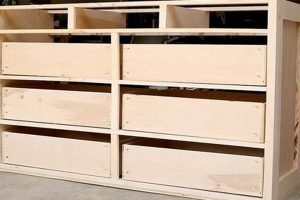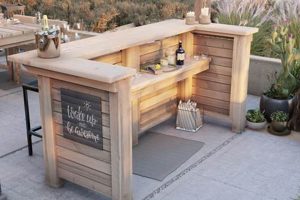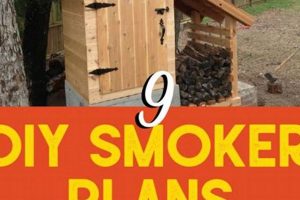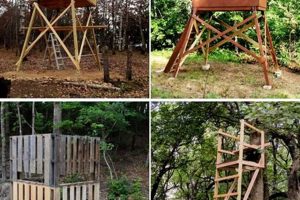Structures engineered for the smoking of food, typically meat or fish, which are conceived, designed, and built by individuals rather than purchased pre-fabricated, can range from simple repurposed containers to elaborate brick or wood constructions. These projects are often undertaken to achieve a desired level of customization or cost savings, or to satisfy a personal interest in traditional food preservation techniques.
The advantages of embarking on such a project include control over materials selection, allowing for avoidance of potentially harmful substances and ensuring food safety. Furthermore, construction of these specialized structures often represents a cost-effective alternative to commercially available options, and can be tailored to specific needs and available space. Historically, smoking food was a crucial preservation method, and modern home-built structures enable continuation of this tradition, providing a connection to past culinary practices.
The subsequent discussion will explore various design options, material considerations, and construction techniques relevant to the successful completion of a personal food smoking enclosure. Focus will be given to factors influencing temperature control, smoke generation, and overall structural integrity.
Considerations for Constructing a Personal Food Smoking Enclosure
The following represents essential guidelines for successful implementation. Attention to these factors contributes significantly to the longevity, efficiency, and safety of the finished structure.
Tip 1: Foundation Stability: A solid, level foundation is paramount. Concrete pads or gravel beds prevent settling and ensure structural integrity, particularly in climates with freeze-thaw cycles.
Tip 2: Material Selection: Opt for food-grade materials such as untreated lumber or stainless steel for surfaces that will come into contact with food. Avoid treated lumber, as it can leach harmful chemicals.
Tip 3: Smoke Generation System: The smoke source must be controllable. Consider a separate firebox connected by a duct, allowing for precise temperature and smoke density regulation.
Tip 4: Ventilation Control: Intake and exhaust vents are crucial for managing airflow and temperature. Adjustable vents allow for fine-tuning the smoking process to achieve desired results.
Tip 5: Temperature Monitoring: Accurate temperature measurement is essential. Install a reliable thermometer at grate level to monitor internal conditions. Digital thermometers with probes offer precise readings.
Tip 6: Structural Integrity: Reinforce the frame to withstand wind and weather. Proper bracing and sturdy construction materials ensure the structure remains stable over time.
Tip 7: Weather Protection: Consider roofing materials and design to prevent rain or snow from entering the smoking chamber. This protects the food and maintains consistent temperature.
Adherence to these guidelines will enhance the performance and safety, resulting in consistent and flavorful smoked products.
The following sections will delve into specific design choices and provide detailed construction methodologies.
1. Material Selection
Material selection is a critical determinant of the success and safety of a homemade food smoking enclosure. The materials chosen directly impact structural integrity, temperature regulation, smoke flavor, and potential contamination of the smoked product. Consequently, careful consideration of these factors is paramount during the planning and construction phases.
Untreated hardwoods, such as oak, hickory, or maple, are frequently selected for their structural properties and contribution to smoke flavor. However, sourcing wood free from chemical treatments is essential to prevent hazardous compounds from leaching into the food. Stainless steel presents another viable option for interior surfaces, offering durability, ease of cleaning, and resistance to corrosion. Conversely, treated lumber, galvanized steel, and plastics are generally unsuitable due to the risk of releasing toxins when exposed to heat. For example, a structure built with treated lumber could render all smoked food inedible, posing a significant health hazard. The design should carefully consider the proximity of each material to food items.
Selecting appropriate materials represents a foundational step. The consequences of poor material selection extend beyond structural instability to potentially hazardous contamination. Understanding the properties and safety profiles of various building materials is therefore imperative. Proper material consideration safeguards against health risks and ensures the longevity and effectiveness of the project.
2. Structural Stability
Within the context of personal food smoking enclosure construction, structural stability represents a non-negotiable requirement. The integrity of the entire structure directly influences its ability to withstand environmental stresses such as wind, snow load, and temperature fluctuations. A structurally unsound enclosure poses significant risks, including collapse, which could lead to property damage, personal injury, or the spoilage of food being processed. This is especially critical considering that these structures are often exposed to high temperatures and potentially flammable materials.
The connection between structural stability and a successful personal food smoking enclosure is clear: the design and execution must account for load-bearing capacity and resistance to deformation. For example, inadequate framing or insufficient foundation support can result in sagging, warping, or even total structural failure over time. This underscores the importance of utilizing appropriate construction techniques, selecting robust materials, and adhering to established building practices relevant to the specific design. A concrete foundation, properly sized lumber for framing, and secure fastening methods are essential elements in ensuring long-term stability. Furthermore, design considerations should encompass factors such as wind resistance and snow load in regions prone to such conditions.
Achieving structural stability in a personal food smoking enclosure extends beyond mere construction technique. It necessitates a comprehensive understanding of load distribution, material properties, and environmental factors. Addressing these considerations ensures the safety and longevity of the structure and, ultimately, the quality and safety of the smoked food produced within it. Failure to prioritize structural stability undermines the entire purpose of the project, rendering it both hazardous and economically unsound. The practical significance of this understanding is paramount for anyone undertaking such a project.
3. Temperature control
Temperature control is paramount in homemade food smoking enclosures, directly influencing the quality, safety, and consistency of the smoked product. Insufficient or excessive temperatures can result in incomplete cooking, bacterial growth, or an undesirable texture and flavor profile. Consequently, design and construction must prioritize temperature regulation mechanisms to achieve optimal results. The effectiveness of a personal food smoking enclosure is inextricably linked to its ability to maintain consistent and controllable heat within a specified range. For instance, cold smoking, typically performed below 85F (29C), requires precise control to prevent spoilage, while hot smoking, which generally occurs between 225F (107C) and 275F (135C), demands sufficient heat to thoroughly cook the food without drying it out. Therefore, a smoker’s design must incorporate features that enable the user to accurately monitor and adjust internal temperatures, and understand the consequences of heat variation.
Achieving precise temperature management necessitates a multi-faceted approach, beginning with proper insulation to minimize heat loss and maintain stable internal conditions. The smoke source plays a crucial role; a separate firebox connected to the smoking chamber allows for more controlled heat input compared to direct heat methods. Furthermore, adjustable vents are essential for regulating airflow, which directly affects temperature and smoke density. The placement and size of vents must be carefully considered to create a balanced system that allows for fine-tuning. For example, strategically positioned vents can facilitate convection, ensuring even heat distribution throughout the smoking chamber, mitigating hot spots that can lead to unevenly cooked food. Regular monitoring with a reliable thermometer is crucial for confirming the effectiveness of temperature control strategies, allowing for real-time adjustments to maintain the desired range.
In summary, temperature control is not merely a design consideration but a fundamental requirement for achieving successful results. Challenges in this area, such as inconsistent heat distribution or difficulty maintaining desired temperatures, can negate the benefits of even the most elaborate construction. Understanding the principles of heat transfer, insulation, and ventilation is essential for designing and operating effective personal food smoking enclosures. The ability to consistently achieve and maintain optimal temperatures is what separates a successful smoker from a potential hazard and a source of frustration. Therefore, prioritizing this aspect is paramount for anyone undertaking a personal food smoking enclosure project.
4. Smoke Generation
In the context of self-constructed food smoking structures, the method of smoke generation significantly impacts the flavor, preservation, and safety of the final product. The choice of system is not arbitrary; it requires a balance between controllability, fuel source, and potential for introducing unwanted byproducts.
- Fuel Source Selection
The selection of fuel source is a pivotal determinant of smoke characteristics. Hardwoods, such as hickory, oak, and fruitwoods, impart distinct flavor profiles. Conversely, softwoods are generally avoided due to their high resin content, which can produce acrid or potentially harmful compounds. The moisture content of the wood also matters; properly seasoned wood burns cleaner and produces a more desirable smoke. For example, applewood offers a mild, sweet flavor, whereas mesquite provides a strong, earthy taste. The selection of fuel source needs to align with the desired taste and intended use of the smoked product.
- Combustion Control
Regulating combustion is essential for managing smoke density and temperature. Inefficient combustion can lead to creosote buildup, increasing the risk of fire and introducing undesirable flavors. Systems utilizing a separate firebox allow for greater control over airflow and combustion rate, minimizing creosote formation. A well-designed system ensures a consistent smolder rather than an open flame. Proper combustion management is a key skill in optimizing the smoke generation process and safeguarding against potential hazards.
- Smoke Delivery System
The method of smoke delivery affects its uniformity and distribution within the smoking chamber. Direct smoke methods, where the fuel is placed directly beneath the food, are often simpler but can result in uneven smoking and localized hot spots. Indirect methods, using a duct or baffle to channel smoke, promote more uniform distribution and prevent direct heat exposure. The delivery system is a factor in achieving consistent results and preventing uneven cooking.
- Cleanliness and Maintenance
Regular cleaning and maintenance of the smoke generation system are vital for safety and performance. Creosote and ash accumulation can obstruct airflow, reduce efficiency, and increase fire risk. Routine inspections and removal of debris are essential. A clean system not only operates more effectively but also minimizes the potential for introducing unwanted flavors or contaminants into the food.
Effective smoke generation is an intersection of fuel selection, combustion management, smoke delivery, and routine maintenance. These facets are not isolated but rather interconnected, influencing both the safety and the final product quality. When embarking on building a personal food smoking enclosure, attention to the design and operation of the smoke generation system is paramount for achieving desired results and preventing hazards.
5. Ventilation design
Ventilation design constitutes a critical element within the broader context of constructing a personal food smoking enclosure. It directly impacts temperature control, smoke density, and overall efficiency. Inadequate ventilation leads to temperature fluctuations, uneven smoking, and potential creosote buildup, ultimately compromising the quality and safety of the smoked product. Conversely, a well-designed ventilation system allows for precise management of these factors, enabling consistent results. The absence of proper airflow renders many other design features, such as insulation and smoke generation methods, less effective. Proper airflow ensures fresh oxygen to combustion source, and proper remove of waste gas to outside.
The practical application of ventilation design principles involves careful consideration of intake and exhaust vent placement and size. Intakes, typically located near the base of the structure, supply fresh air to the combustion source. Exhaust vents, positioned higher up, facilitate the removal of smoke and moisture. Adjustable vents provide a means of controlling airflow, allowing the user to fine-tune the smoking process based on prevailing environmental conditions and the type of food being smoked. For instance, smoking delicate fish may require lower temperatures and higher humidity, necessitating restricted airflow. The success of this system hinges on a careful balance: sufficient airflow to maintain combustion without creating excessive drafts that disrupt temperature stability. In some designs, dampers could be used to control the flow of air.
In conclusion, ventilation design is not merely an ancillary consideration but an integral component of successful personal food smoking enclosure construction. It serves as a crucial regulator of temperature and smoke, directly influencing the outcome of the smoking process. Mastering the principles of airflow and vent placement translates to enhanced control, consistency, and ultimately, higher-quality smoked products. Overlooking this facet of design undermines the benefits of other features, such as precise smoke generation. The connection to ventilation design and food safety is direct.
6. Food Safety
The construction of a personal food smoking enclosure presents inherent food safety risks that demand diligent attention. These risks stem primarily from potential temperature inconsistencies, inadequate smoke exposure, and the introduction of contaminants from construction materials or combustion byproducts. Improper construction or operation directly increases the likelihood of bacterial growth, incomplete cooking, or the presence of harmful chemicals in the final smoked product. This, in turn, can lead to foodborne illnesses with potentially severe health consequences. A poorly designed structure, for example, may fail to maintain a sufficiently high internal temperature for a prolonged period, creating an ideal environment for pathogens such as Salmonella or E. coli to proliferate. Similarly, inadequate ventilation could result in the accumulation of creosote, a known carcinogen, on the surface of the food.
Mitigating these risks necessitates a thorough understanding of food safety principles and their application in the context of personal food smoking enclosure design and operation. Key considerations include selecting appropriate construction materials, ensuring adequate ventilation, maintaining consistent and verifiable temperatures, and implementing rigorous sanitation practices. For example, using untreated lumber for interior surfaces and employing a calibrated thermometer to monitor internal temperatures are crucial steps in minimizing contamination and ensuring proper cooking. Additionally, adhering to established food handling guidelines, such as washing hands thoroughly and avoiding cross-contamination between raw and cooked products, further reduces the risk of foodborne illness. It is also essential to understand the USDA guidelines for safe internal cooking temperatures for different types of meat and poultry.
In conclusion, food safety must be the foremost consideration in any personal food smoking enclosure project. Neglecting this aspect can lead to serious health consequences, undermining the intended benefits of home smoking. By prioritizing careful planning, utilizing safe construction practices, and implementing rigorous operational protocols, individuals can minimize the risks associated with home smoking and ensure the production of safe and enjoyable smoked foods. A responsible approach to this process is crucial for protecting public health and preserving the tradition of safe food preservation.
7. Weather resistance
Weather resistance is a critical design parameter for any personal food smoking enclosure, impacting its longevity, operational efficiency, and the consistency of the smoking process. Exposure to the elements, including rain, snow, wind, and sunlight, can degrade construction materials, compromise structural integrity, and disrupt temperature regulation. The absence of adequate weather protection can lead to accelerated decay of wooden components, corrosion of metal parts, and water intrusion into the smoking chamber, all of which undermine the structure’s functionality. For example, a roof that leaks rainwater will not only damage the food being smoked but also compromise the insulation, rendering temperature control significantly more difficult. The effects of harsh weather can range from minor inconveniences to catastrophic failures, jeopardizing both the investment in the structure and the safety of its operation.
Practical applications of weather-resistant design involve several key considerations. Implementing a pitched roof with appropriate overhangs effectively sheds rainwater and snow, preventing water accumulation around the base of the structure. Selecting weather-resistant materials, such as treated lumber or exterior-grade plywood, for the outer shell provides enhanced protection against moisture damage. Sealing joints and seams with caulk or sealant prevents water intrusion and minimizes air leaks, further enhancing temperature control. Coating the exterior with a weather-resistant paint or stain provides an additional layer of protection against the elements. The orientation of the structure also plays a role; positioning the enclosure to minimize exposure to prevailing winds and sunlight can mitigate the effects of weather. Furthermore, ensuring that the foundation allows for proper drainage prevents water from pooling around the base, which can lead to rot and structural damage.
In summary, weather resistance is not merely an optional feature but a fundamental requirement for a successful personal food smoking enclosure. It is a vital component in maintaining the structure’s integrity, ensuring consistent operational performance, and prolonging its lifespan. Addressing weather resistance comprehensively, through careful material selection, design considerations, and construction techniques, safeguards the investment, protects the food being smoked, and contributes to the overall success of the project. Failure to account for the impact of weather undermines the benefits of other design features and can result in costly repairs or even complete structural failure. The connection to product quality and a safe project lifespan is direct.
Frequently Asked Questions Regarding Personal Food Smoking Enclosure Construction
The following represents common inquiries concerning the design, construction, and safe operation of custom food smoking structures. These answers aim to provide clear and concise information based on established best practices.
Question 1: Is a building permit required for personal food smoking enclosure construction?
Permitting requirements vary significantly by jurisdiction. Consultation with local building authorities is essential to ascertain compliance with zoning regulations, construction codes, and fire safety standards. Failure to obtain necessary permits can result in fines or mandatory removal of the structure.
Question 2: What are the recommended dimensions for a starter personal food smoking enclosure?
Optimal dimensions depend on intended usage and available space. A general guideline for a small-scale structure is 4 feet wide, 4 feet deep, and 6 feet tall. This allows sufficient space for hanging or placing food while maintaining a manageable footprint. Individual needs may necessitate adjustments to these dimensions.
Question 3: Can repurposed materials be utilized in personal food smoking enclosure construction?
Repurposed materials may be suitable provided they are food-grade and free from contaminants. Materials previously used for chemical storage or treated with hazardous substances should be strictly avoided. Thorough cleaning and inspection are essential to ensure safety.
Question 4: What is the best method for insulating a personal food smoking enclosure?
Proper insulation is critical for maintaining consistent temperatures. Fiberglass insulation, rockwool, or ceramic fiber blankets can be used, ensuring they are properly enclosed and protected from direct contact with food or smoke. Reflective barriers, such as aluminum foil, can further enhance insulation performance.
Question 5: How frequently should a personal food smoking enclosure be cleaned?
Regular cleaning is essential for preventing creosote buildup and maintaining sanitary conditions. The interior should be cleaned after each use, removing ash, grease, and food debris. A more thorough cleaning, including scrubbing and disinfection, should be performed periodically, depending on usage frequency.
Question 6: What safety precautions should be observed during the operation of a personal food smoking enclosure?
Operating food smoking structures presents inherent fire hazards. A fire extinguisher should be readily available, and flammable materials should be kept at a safe distance. The structure should never be left unattended while in operation. Proper ventilation is crucial to prevent carbon monoxide buildup. It’s important to understand the dangers of unattended heat sources.
Adherence to these guidelines contributes to the safe and effective construction and operation of food smoking structures. Diligence in these matters is essential for achieving desired results and minimizing potential hazards.
The subsequent discussion will address design choices and construction methodologies in detail.
DIY Smokehouse Plans
This exploration has underscored the multifaceted nature of food smoking enclosure construction. From initial design concepts to material selection, structural stability, temperature control, smoke generation, and food safety, each element contributes significantly to the success and safety of the project. Understanding the interdependencies of these variables is paramount for achieving consistent results and minimizing potential hazards. The guidelines presented offer a structured approach to navigating the complexities inherent in building these specialized structures.
The construction and utilization of structures dedicated to food smoking represents a significant investment of time, resources, and effort. It is therefore incumbent upon those undertaking such projects to prioritize comprehensive planning, meticulous execution, and unwavering adherence to established safety protocols. Careful consideration of these factors will not only enhance the quality of the final product but also safeguard against potential health risks, ensuring a rewarding and sustainable food preservation practice.



![Best DIY Slide In Truck Camper Plans [Easy Build Guide] The DIY Hub: Creative Crafts, Repairs & Life Hacks Best DIY Slide In Truck Camper Plans [Easy Build Guide] | The DIY Hub: Creative Crafts, Repairs & Life Hacks](https://craftingdiycenter.com/wp-content/uploads/2025/07/th-1432-300x200.jpg)



